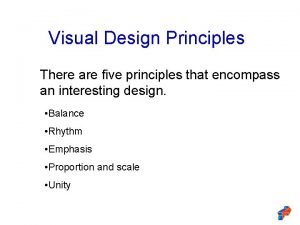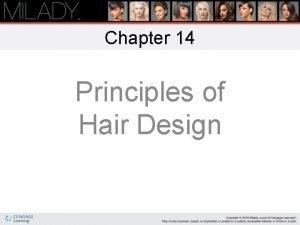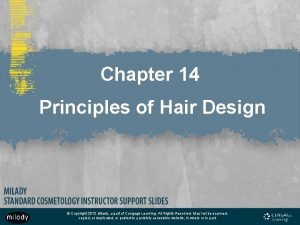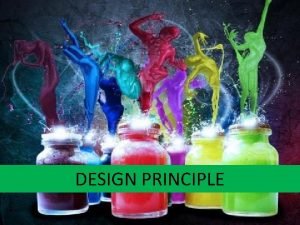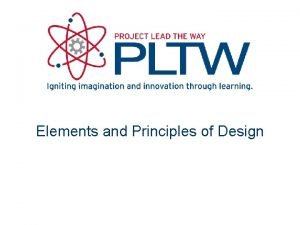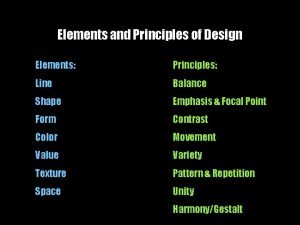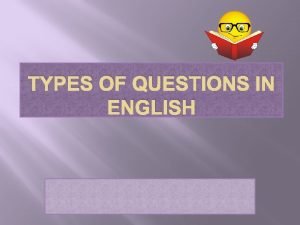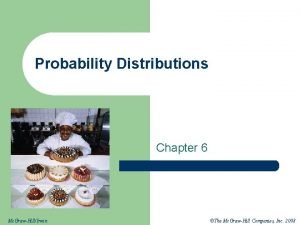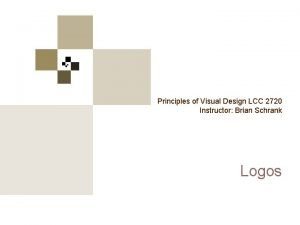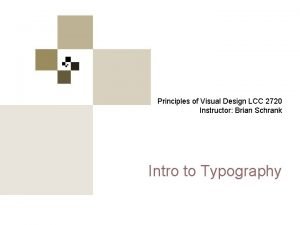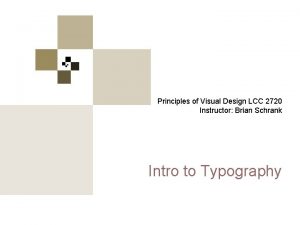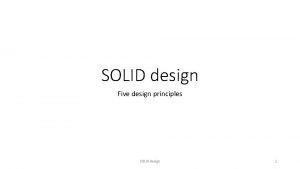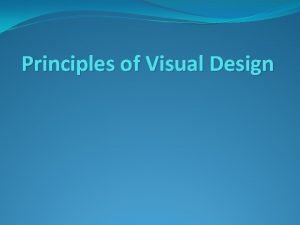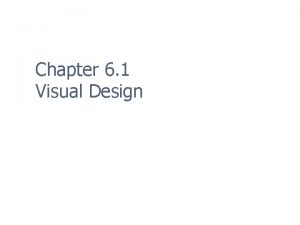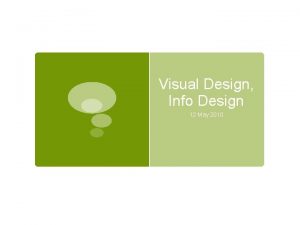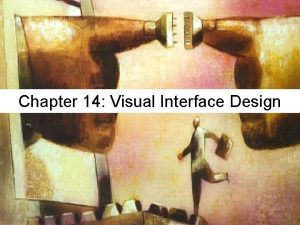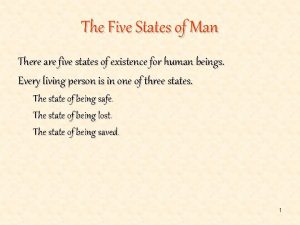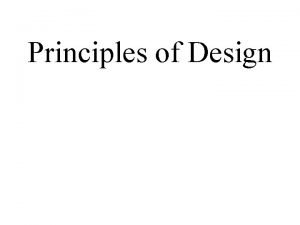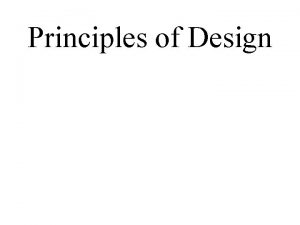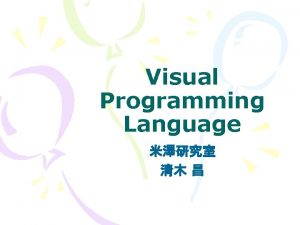Visual Design Principles There are five principles that































- Slides: 31

Visual Design Principles There are five principles that encompass an interesting design. • Balance • Rhythm • Emphasis • Proportion and scale • Unity

Balance Parts of the design are equally distributed to create a sense of stability. There can be physical as well as visual balance. Types • Symmetrical or Formal Balance • Asymmetrical or Informal Balance • Radial Balance • Vertical Balance • Horizontal Balance

Balance Symmetrical or Formal Balance The elements within the design are identical in relation to a centerline or axis.

Balance Asymmetrical or Informal Balance Parts of the design are not identical but are equal in visual weight.

Balance Radial Balance Design Elements radiate outward from the center.

Balance Vertical Balance The top and bottom parts are equal.

Balance Horizontal Balance The left and right parts are equal.

Rhythm Repeated use of line, shape, color, texture or pattern. Types • Regular rhythm • Graduated rhythm • Random rhythm • Gradated rhythm

Rhythm Regular Rhythm A element is repeated at the same repetition each time.

Rhythm Graduated Rhythm The beats of the element become closer or further apart as they move.

Rhythm Random Rhythm The beats of the element are random or are at irregular intervals.

Rhythm Gradated Rhythm The repeated element is identical with the exception of one detail increasing or decreasing gradually with each repetition.

Emphasis • Points of attention in a design. • The feature in a design that attracts one’s eye. • The focal point. • Emphasis can be achieved through size, placement, color and use of lines. • The most personal aspect of a design.

Proportion and Scale • Comparative relationships between elements in a design with respect to size. • 3: 5 ratio is known as the Golden Mean. • Scale • The proportions or size of one part of the image in relationship to the other.

Unity • Unity is applying consistent use of lines, color, and texture within a design. • To be harmonious.

Unity

Readability/Typography • Style of type, font • Size of type, point • Font enhancements, – underline, shadow, word art • White space • Line length and justification • Color of the text and color of the text background • Page layout

Graphic Design • Audience Analysis – Who is the audience? – What are their demographics? – Where are they located? – How long do they have to read the message? – What is their anticipated level of interest? – Trends?

Demographics • • Age Sex Social status Religion Education level Economic level Interests

Location • Where are they in reference to the Message? – Distance • Where are they? – Describe Location

Time • How long do they have to read the message? • What is in competition with the message for reading time?

Interest • How interested is the audience in the subject of the message? • What do they like or dislike? • What interest can be exploited to get the audience to read the message?

Human factors • • Values Beliefs Attitudes Character Temperament Outlook Perspectives

Effective Graphic Design • Incorporates Message Analysis Message Content - concise but complete Size and Shape - how the message is to be delivered Readability – typography Needs the Audience - understands demographics Use of proven Design Principles and Elements

Visual Design Elements • Six integral components in the creation of a design: • Line • Space • Color • Texture • Form/Shape • Value

Line Types • Vertical- Represents dignity, formality, stability and strength. • Horizontal- Represents calm, peace and relaxation. • Diagonal- Represents action, activity, excitement and movement. • Curved- Represents freedom, the natural, having the appearance of softness and creates a soothing feeling or mood.

Color has an immediate and profound effect on a design. Types • Warm Colors • Reds, oranges, yellows • Cool Colors • Blues, purples, greens • Colors can affect how humans feel and act.

Form and Shape The shape, outline, or configuration of anything. Examples • Squares • Ovals • Circles • Rectangles • Ellipses • Triangles

Space By incorporating the use of space in your design, you can enlarge or reduce the visual space. Types • Open, uncluttered spaces • Cramped, busy • Unused vs. good use of space

Texture The surface look or feel of something. Types • Smooth surface • Reflects more light and, therefore, is a more intense color. • Rough surface • Absorbs more light and, therefore, appears darker.

Value The relative lightness or darkness of a color. Methods • Shade Degree of darkness of a color • Tint A pale or faint variation of a color
 Mikael ferm
Mikael ferm Phân độ lown ngoại tâm thu
Phân độ lown ngoại tâm thu Block nhĩ thất độ 2 mobitz 2
Block nhĩ thất độ 2 mobitz 2 Thể thơ truyền thống
Thể thơ truyền thống Thơ thất ngôn tứ tuyệt đường luật
Thơ thất ngôn tứ tuyệt đường luật Walmart thất bại ở nhật
Walmart thất bại ở nhật Tìm độ lớn thật của tam giác abc
Tìm độ lớn thật của tam giác abc Con hãy đưa tay khi thấy người vấp ngã
Con hãy đưa tay khi thấy người vấp ngã Tôn thất thuyết là ai
Tôn thất thuyết là ai Gây tê cơ vuông thắt lưng
Gây tê cơ vuông thắt lưng Sau thất bại ở hồ điển triệt
Sau thất bại ở hồ điển triệt Five principles that encompass an interesting design.
Five principles that encompass an interesting design. Element of hair
Element of hair Chapter 14 principles of hair design worksheet
Chapter 14 principles of hair design worksheet Chapter 14 principles of hair design
Chapter 14 principles of hair design Which element of hair design is used
Which element of hair design is used Design principles contrast
Design principles contrast Elements and principles of design matrix
Elements and principles of design matrix Visual elements and principles of design
Visual elements and principles of design 2018 viscom exam report
2018 viscom exam report The sounding cataract haunted me
The sounding cataract haunted me One in five challenge
One in five challenge 5 senses and 5 elements
5 senses and 5 elements Dew the sovereign flower and drown the weeds
Dew the sovereign flower and drown the weeds 5 types of questions in english
5 types of questions in english All the beds were
All the beds were There are five flights daily from pittsburgh
There are five flights daily from pittsburgh Show that there are exactly five 3-digit cube numbers.
Show that there are exactly five 3-digit cube numbers. Bahasa pemrograman konvensional
Bahasa pemrograman konvensional Elements of interior design ppt
Elements of interior design ppt There is there are ejemplos
There is there are ejemplos There is there are part of speech
There is there are part of speech











